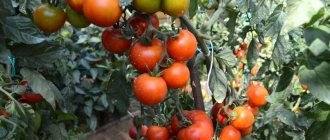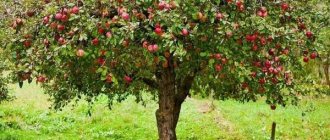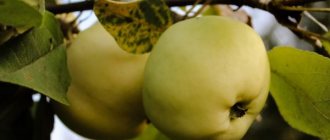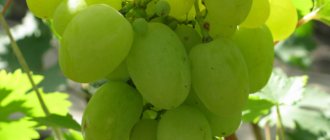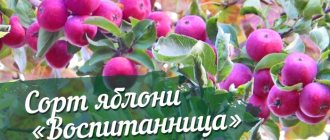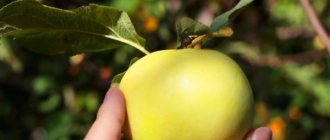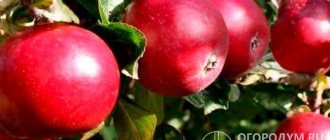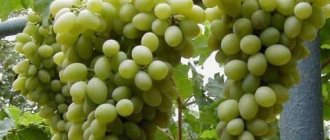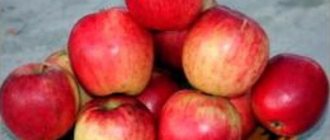White filling is an ancient variety that remains popular to this day. Gardeners value it for its early plump apples, white and tender, tasty and beautiful. The variety is productive and durable; having a white filling in the garden is a matter of honor for every gardener.
Variety "White filling"
The pulp is white and juicy, but if it is overripe, it will become mealy (cotton-like)
History of origin of the variety
There is no clear opinion regarding the origin of White Filling. Some experts believe that the variety comes from the Baltics, others are sure that it is an old Russian variety that originated in the Volga region. And from the Baltic states another variety came to us - Papirovka (translation from Polish - “paper apple”). It looks similar to White filling, but upon closer inspection there are many differences. Note that today many authoritative sources do not distinguish between these varieties.
Like any ancient variety, White filling has acquired many names, among the most famous are Dolgostebelka, Bulk White, Pudovshchina. It was widely used in breeding, with its participation about two dozen new varieties were bred.
Reviews from gardeners
Gardeners characterize the variety as very productive. The plant is unpretentious in care. The apple tree deserves high marks in all respects, except for its short shelf life and susceptibility to scab. To increase productivity, you need to apply various fertilizers in spring and autumn. To prevent scab, gardeners recommend spring preventive spraying with copper-containing preparations.
“White filling” is officially recognized as one of the unpretentious and productive summer varieties of apple trees. Even the most inexperienced gardener can grow a fruit tree. “White filling” is common in Russia.
Description and characteristics of the White filling apple tree
The variety is unique for its long lifespan. There are specimens that, having lived up to 70 years, continue to bear fruit. True, with age the fruits become somewhat smaller. The variety is easy to recognize by its characteristic external features.
White filling is a summer early ripening variety. Ripens differently in different climate zones:
- in the south - mid-July;
- middle zone - mid-August;
- Siberia – second half of August.
Tree
The White filling apple tree is a classically beautiful medium-sized tree. It reaches a height of 5 m. Features of the tree:
- Bark. Color – light grey. Young apple trees have smooth bark. Over time it becomes rough.
- Crown. While the tree is young, its crown is elongated - pyramidal in shape. An adult tree acquires a rounded, moderately spreading crown.
- Leaves. The shape is ovoid. Color – green, size – medium, slightly pubescent on the inside. They differ from other varieties by having longer petioles (that is why they are called Long-stemmed).
- Flowers. Large, white, saucer-shaped. There is often a pinkish “patina” on the petals. Flowers are in large inflorescences.
Fruit
Fruit formation is on white-green ringlets. Description of fruits:
- Form. The apples are large, round-conical, tapering towards the cup.
- Weight. Fruits on young apple trees grow up to 150 g, on old ones - up to 60 g.
- Pulp. White, juicy, sweet taste, with slight sourness and a subtle apple aroma.
- Color. Green apples turn white when ripe. Apples hanging on the south side of the tree become covered with a delicate light pink blush when ripe. On one side of the fruit there is a seam running from the tail to the cup.
- Skin. Thin, compared to the pulp - sour.
- Taste. Changes as it matures. Unripe fruits are sweet and sour. As apples ripen, they become sweeter, the sugar content increases, and the fruit acquires a dessert taste with a barely noticeable sourness. The fruits generously filled with juice are especially tasty. Tasting score – 4.7.
White filling apples are delicious fresh and are a valuable raw material for processing. They are used to make jam, marmalade, juices and wines. The fruits are quite sweet - they contain 9% sugar.
You can see an overview of the White Filling variety in the video below:
Root system
The type of root system is determined by the characteristics of the rootstock:
- vigorous-growing ones have a powerful central rod;
- low-growing (dwarf and semi-dwarf rootstocks) - a highly branched root system that does not have a central core.
Productivity
White filling is a productive variety. With good care, the tree is simply covered with fruits. The average yield is 80 kg per tree. If the tree is provided with ideal conditions, it can produce up to 200 kg of apples.
The first apples are harvested in the fifth year of planting a two-year-old seedling. Fruiting as the tree matures acquires a certain periodicity.
Self-fertility and pollinating varieties
The variety is self-sterile - it needs pollinators. For pollination of White filling, it is recommended to use:
- "Antonovka";
- "Ottawa";
- "Lungwort";
- “Moscow Grushovka”;
- "Candy";
- “Golden Chinese woman”;
- "Cypress";
- “Early pear”;
- "Mantet."
If a pollinating variety is not planted nearby, there will be few ovaries on the tree, and their size will be smaller than normal. As pollinators, mainly varieties are selected whose flowering coincides with the flowering of White Fill.
Winter hardiness
The variety is winter-hardy, able to withstand harsh winters, preserving the ovaries. It also survives spring frosts well for the future harvest. The winter hardiness of the variety is not enough for growing in the northern regions - growing White filling here is not practical.
Disease resistance
The variety does not have high immunity. White filling is affected by a number of diseases and pests, and therefore requires preventive treatment. Thus, White filling does not have immunity from one of the most serious diseases of fruit trees - scab. This scourge especially actively affects thickened and unthinned trees. Wet weather also contributes to scab.
Subspecies and options
White filling has many variations - different varieties of filling apples were developed on its basis:
- Golden Pouring. Large-fruited variety with apples of pale golden color. Fruit weight - 140 g. Almost does not suffer from scab and black cancer. This variety is not listed in many catalogs.
- Pink filling. The fruits are large - from 200 g. Salad color, with blush. The shape is turnip-shaped. Distributed mainly in the Nizhny Novgorod region.
- Honey pouring. The most delicious bulk variety. The fruits are small - 70-90 g. The apples are sunny yellow. Rarely suffers from scab. Winter hardiness is low.
- Ural filling. Small fruits (100 g) with almost no aroma. Greenish-golden apples with blush. High winter hardiness and early fruiting - harvest for 2-3 years.
- Steppe. Small yellowish fruits - up to 45 g. Distributed in the Far East. Winter-hardy.
- Isetsky. The fruits are medium size (130 g), light yellow in color. High early maturity and winter hardiness.
White filling can be grown on different rootstocks; there are three types of this variety:
- Dwarf. Superior to other species in yield. It is convenient to grow and care for - the height of the plant is only 3 m. The species is unpretentious and can grow where vigorous trees do not grow. Not afraid of high groundwater. Takes up little space. It is early-bearing – it bears fruit within 2-3 years. For good results, it is necessary to follow agricultural techniques, water and feed on time.
- Semi-dwarf. Slightly different from the dwarf species. Trees differ already in adulthood. The semi-dwarf species is approximately 25% larger than the dwarf species, its height reaches 4 m.
- Creeping. This low-growing form is characterized by maximum frost resistance. Can bear fruit in Siberia.
Video: Compote of whole apples for the winter
- Diet apple pie
To prepare the dessert you will need:
- flour - half a glass;
- oatmeal - half a glass;
- eggs – 3 pcs.;
- baking powder – 0.5 teaspoon;
- odorless vegetable oil - 3 tbsp. spoons;
- apples – 3 pcs.;
- honey - 2 tbsp. spoons;
- cinnamon.
Sift the flour, add baking powder and oatmeal. Separate the whites from the yolks. Beat the whites into a thick foam, grind the yolks with honey and vegetable oil. Mix with egg whites, add everything to flour, knead the dough carefully with a spoon. It should be of medium thickness. Pour into a mold lined with parchment paper. Place in the oven for 10 minutes, preheated to 180 degrees Celsius. Peel the apples and cut into thin slices. Place on the dough, brush with honey, sprinkle with cinnamon, and bake for another 25 minutes.
- Apple cookies
Ingredients:
- Soft butter - 60 g;
- Vanillin - 1/3 packet;
- Baking powder - 0.5 teaspoon;
- Sugar - 3 tbsp. spoons;
- Egg - 1 pc.;
- Flour - 130 g;
- Apple without peel - 2 pcs.
Cut the White filling into cubes. Grind butter with sugar and vanilla. Add the egg. Add flour with baking powder. Combine with apples and mix. Line a baking sheet with parchment paper and grease with vegetable oil. Spoon onto the cakes with a wet spoon, forming cookies. Bake at 180 degrees for 15 minutes. The cookies turn out fragrant and crispy.
Landing Features
When planting seedlings, the climatic conditions of the region, specific weather conditions and the requirements of the variety for growing conditions are taken into account.
Conditions for landing White Fill:
- The best soils are loam.
- Wet soils are not suitable.
- If the site is located in a lowland, its seedlings are planted on a hill.
- The lighting must be good. Sites sloping to the south or southwest are recommended.
- The site must have protection from the north wind - in the form of planting, a fence, a wall. The distance from the protective barrier to the tree is at least 2.5 m.
- If the seedling is planted on clay soils, its structure is improved by adding river sand to the planting hole.
- The optimal soil acidity is pH 66.5 (neutral and slightly acidic).
There should be no roots of other trees near the planting site - they will take water and nutrients from the soil.
Disembarkation dates
When to plant White filling - in spring or autumn, depends on the climate zone - in regions with harsh winters, the spring option is preferable.
Seedlings are planted no earlier than the end of April. The deadline is early May. The landing condition is warm and dry soil. Spring planting is recommended for young seedlings.
If the seedlings are more than two years old, autumn planting is possible - in early October. From the moment the seedling is planted until the first frost and freezing of the soil there should be at least a month - based on this condition, the time of planting is determined.
Preparatory activities
Before planting, the seedling is soaked in water for a day. But the hole is made a month before planting. Features of pit preparation:
- The scheme for planting seedlings is 4x5 m.
- A hole is dug - 80-90 cm in diameter, 60-70 cm deep. On clay soils, the depth of the hole is 1 m (including drainage).
- Mixed equal parts of chernozem, peat, humus and sand are poured into the pit. Add superphosphate - 300 g, and wood ash - 3 liters.
If a hole is dug in the fall, only humus (1:1 mixed with soil) and ash (0.5 l) are added to it; if in the spring, fertilizer is added to the last portion of soil, which is sprinkled on the seedling.
Step-by-step instructions for planting
The procedure for planting a seedling:
- Inspection of the seedling. If brown spots appear on the root sections, trim the ends. Check for the presence of putrefactive lesions - they should also be trimmed. If you missed the moment of lowering it into the mash, do it immediately before planting - to prevent the roots from drying out.
- The prepared seedling is lowered into a hole in which a support peg has already been placed. The latter is placed so that it covers the plant from the sun - on the south side of the trunk.
- Straighten the roots, carefully placing them on a hill of soil-humus mixture. Make sure that the root collar does not end up below the ground level; it should be about 5 cm above the ground.
- The hole is filled with fertile soil, tamping thoroughly. When sprinkling the hole, shake the trunk well - this helps fill the voids formed between the roots with the soil. This technical nuance of planting will prevent the tree from drying out.
- The trunk is tied to a support peg - it will prevent sunburn and protect the roots from loosening in strong winds.
- Watered. One tree requires 3 buckets of water.
- Mulch the soil near the trunk to retain moisture. Mulch thickness – from 5 cm.
Care and cultivation of the White filling variety
There is nothing special in caring for the White filling, but the more care is taken for the tree, the greater its return will be - higher yield, larger and tastier apples.
Watering, loosening and weeding
White filling is responsive to moisture. With frequent (in moderation) watering, the fruits will be juicier. Watering rules:
- Do not over-moisten the soil - this leads to rotting of the roots.
- Irrigation options – sprinkling, drip, ground, surface. It is advisable to water at cool times of the day. The best time is evening.
- The watering norm for an annual tree is 2 buckets. Further, the norm doubles every year. Two-year-old trees are given 4 buckets, etc. Trees older than 5 years are watered with 50-100 liters per 1 sq. m. m.
- The first spring watering is carried out before the buds open.
- The second watering for adult apple trees is carried out during the formation of ovaries.
- The third watering is a few weeks before harvest.
- The last watering is in October, its purpose is to prevent the tree from freezing in winter. Water in warm weather.
For the first 5 years, it is recommended to water the seedlings weekly.
You should not water apple trees during the ripening period and after harvesting. When the growing season is not over, watering will promote the growth of young shoots that are not adapted to winter. The tree will freeze and may even die.
Each watering is completed by loosening. Then sprinkle mulch on the soil near the trunk to aerate the roots and retain moisture. It is also necessary to pull out weeds - they take nutrients from the soil intended for the tree. Weeds speed up the drying out of the soil. Timely weeding prevents weed seeds from ripening and shedding.
Feeding
The nutrients that the tree is supplied with during planting are enough for 3-4 years of life. Next, the apple tree needs feeding. There are no specific feeding requirements for White Fill.
Fertilizer application for the White filling variety is carried out according to the standard scheme for apple trees:
- Organic fertilizer - compost/humus, is applied once every 3-4 years during spring digging. Application rate – 5-7 kg per 1 sq. m.
- Mineral fertilizers are applied every year:
- in spring - urea or carbamide (30-40 g per 1 sq. m);
- during the period of fruit formation, and then after 2-3 weeks again - a solution of potassium monophosphate (10-20 g per 1 sq. m);
- in the fall, during digging - superphosphate (30-40g per 1 sq. m.);
- In summer it is possible to fertilize with manure - liquid mullein or diluted chicken droppings.
They begin to feed White filling in the spring, as soon as the growing season starts.
For apple trees growing in acidic soils, chalk or lime is added every 4 years - 200 g per tree to neutralize acidity. Instead, dolomite flour or even old plaster is suitable.
Doses of fertilizers for one apple tree are in Table 1.
Table 1
| One year after landing | Diameter of the tree trunk circle, m | Compost, kg | Urea or ammonium nitrate, g | Calcium nitrate or ammonium sulfate, g | Double superphosphate, g | AVA fertilizers (phosphorus) | Potassium sulfate, g | Ash, g |
| 3-4 | 2,5 | 15-20 | 45 | 100 | 47 | 40 | 60 | 230 |
| 5-6 | 3 | 20-25 | 65 | 150 | 70 | 60 | 90 | 340 |
| 7-8 | 3,5 | 30-40 | 130 | 300 | 90 | 78 | 120 | 460 |
| 9-10 | 4 | 40-45 | 160 | 375 | 116 | 100 | 150 | 580 |
| 11-12 | 4,5 | 50-60 | 260 | 600 | 186 | 150 | 300 | 1160 |
Pruning and crown formation
White filling, like other varieties of apple trees, requires 4 types of pruning:
- Formative. A sparsely tiered crown is recommended. The number of tiers is 2 or 3. The crown should be formed from 5-6 skeletal branches extending from the trunk at an angle of 60-70 degrees. Branches extending at a smaller angle are bent with twine or a weight. The crown is formed during the first 3-4 years of the tree’s life.
- Sanitary. Remove all damaged and old branches.
- Rejuvenating. The growth of an apple tree subsides by the age of 25-30. During this period, the tree requires chasing - pruning to 2-3 year old wood.
- Supportive. 80% of fruit wood consists of ringlets. Moreover, among the branches that extend at an acute angle, many are prone to breaking off - they should be bent or cut out. The variety has many paired branches – “sleeves”; the weaker shoot needs to be removed. Pruning is done while the tree is young - so that there are fewer wounds. Aging and unproductive rings and other formations are regularly removed. The branches should be shortened taking into account the growth force; the faster the shoot grows, the larger the cut end.
The first pruning is carried out before planting - to form a compact crown. Then, every spring, old and diseased branches are removed. Pruning is carried out before sap flow begins.
To prevent flowering from depleting the young tree, the flowers are plucked off in the first years. In subsequent years, their number is regulated to prevent overload.
What can be vaccinated?
Basic rules for grafting White filling:
- Grafting according to the “seed to seed” principle.
- Grafting onto a variety that matches the ripening period.
Experts do not recommend using White filling as a rootstock for winter varieties.
You can learn more about methods of grafting an apple tree in spring from this article.
How to propagate white filling?
Methods of propagation of White filling:
- Vaccination. They are grafted with buds or cuttings: onto an apple tree of a different variety, onto a rowan or pear;
- to the wild;
- to clonal rootstock.
Preparing for winter
In winter, the bark of White Naliv is a treat for rodents. To protect the trunk, gardeners usually use roofing felt - they wrap it around the tree. Instead of roofing felt, you can use burlap or dense mesh. Another option is to coat the trunk with liquid compounds, such as rendered lard or another substance that repels hares.
Young trees need special care - if their bark is damaged, they will (most likely) die in winter. Spruce spruce branches are used to protect against the cold. It is also important to protect the roots of the plant - for this, all trees under 5 years old are mulched with manure around the trunks. If the winter has little snow, the trunk is hilled to a height of 15-20 cm.
Ripening and fruiting
The timing of flowering, ripening and fruiting of White Fill depends on the climatic characteristics of the region, and may shift depending on weather conditions.
Beginning of fruiting
The beginning of fruiting depends on the type of variety. So, one tree can produce fruit in the second year of planting, while another can produce fruit only 6 years after planting. It all depends on the rootstock. Apple trees on dwarf rootstocks begin to bear fruit earlier, but also stop earlier.
Bloom
A distinctive feature of White filling is its large flowers. Flowering is abundant - the tree is simply strewn with flowers. In the middle zone, flowering occurs at the beginning of May. In more southern regions, for example in the Stavropol Territory, the variety blooms somewhat earlier. The timing of flowering also depends on specific weather conditions. Early flowering is always risky - the ovaries may be damaged by frost.
Apple ripening time
In many orchards, White filling is the first apple. They usually ripen by the end of July or early August. In any case, by August 20 they will definitely ripen. The timing of ripening, as well as flowering, depends on weather conditions. The collection is carried out in two stages, taking a break for 1.5-2 weeks.
Cyclicity of fruiting
The white filling bears fruit with a certain cyclicity. Moreover, you never guess how often the harvest will be. You can try to regulate the yield, but the cyclicality depends on deep factors that cannot be controlled.
Gardeners are planting several White Fill trees - if you are lucky and the cyclicity does not coincide, then there will be white apples in the garden every summer. It happens that some trees bear fruit every year, but their apples are small, while others produce large fruits, but every other year.
What to do if the apple tree does not bloom or bear fruit?
If the apple tree does not bloom or bear fruit, a mistake was probably made or there are some external reasons. Lack of fruiting may occur due to:
- improper planting - the root collar may be buried in the soil;
- poor soil or nearby trees negatively affect growth;
- pests and diseases;
- improper crown formation.
Gardeners often face the problem of apples falling. This problem can also have several reasons:
- insufficient hydration;
- defeat by codling moth;
- unfavorable weather conditions.
Pollinator trees
There are several pollinating trees that contribute to the formation of the fruits of the White Fill apple tree. It is advisable to take varieties that bloom and produce crops at the same time as this variety. Here are some of them:
- Anise;
- Mantet;
- Grushovka.
- Mac;
- Antonovka;
- Quinty;
- Golden Delicious;
- Champion.
Mantet
Mac
Golden Delicious
Diseases and pests
To prevent diseases and the spread of pests, it is recommended to carry out a number of activities annually:
- collect and destroy weeds and plant debris;
- dig the soil deeper;
- thin out the crown, carry out sanitary pruning;
- clean damaged bark, whiten the trunk and skeletal branches;
- attach fishing belts to the boles;
Diseases and pests that threaten the White Naliv variety are in Table 2.
table 2
| Pests/diseases | Symptoms of the lesion | What to do? |
| Scab | First, light green oily spots appear on the leaves, which then become brown and velvety. Later, spots appear on the fruits, they crack and become deformed. | Treating the tree and soil during bud break with Bordeaux mixture - 400 g per 10 liters of water. Treatment with Fitolavin and Rayek also helps. |
| Powdery mildew | Affects all parts of the tree. The leaves turn yellow and dry, the tree does not bear fruit and dies. | At the moment the leaves bloom, spray with Bordeaux mixture or Topaz - 2 ml of product per bucket of water. After flowering, the apple tree is sprayed with copper oxychloride. The third spraying is 1% Bordeaux mixture. Instead, you can prepare a solution: take 50 g of copper sulfate and 20 g of liquid soap per bucket of water. |
| Apple codling moth | 3 weeks after flowering, the butterfly lays eggs on leaves and fruits. Caterpillars eat the pulp of fruits and even seeds. Losses can amount to 90% of the harvest. | Treatment with insecticides 2.5 weeks after flowering. Suitable drugs, for example, are “Methadione”, “Cidial”, “Zolon”. |
| Green apple aphid | Settles on foliage and shoots. The leaves curl, the shoots dry out. There are 10 generations of aphids per season. This pest greatly weakens the plant. | Spray with insecticides after the buds open. If there are a lot of aphids, spraying is repeated. |
| Apple flower beetle | The butterfly lays eggs in the buds. The larvae eat away the receptacle and the buds wither. Beetles emerge from pupae in the flower. | Treatment with insecticides during bud break, a second time when the beetles emerge from the buds. |
Video: The softest cookies with apples
- Pickled apples
There are a huge number of recipes. Differences in additives that change the taste of apples.
Ingredients:
- apples – 20 kg;
- cold water – 10 l;
- basil – 100 g;
- black currant leaves – 20 pcs.;
- rye flour – 150 g;
- honey – 500 g;
- coarse salt – 170 g.
The water is boiled and allowed to cool to 40 degrees. Gradually add flour, salt, honey, stir until dissolved. Leave the brine to cool. Thoroughly wash apples and currant leaves. Currant leaves are placed in layers at the bottom of a deep pan or bucket. Place apples and basil on top and repeat again. Lay the rest of the currant leaves on top. Fill with brine and cover with a lid slightly smaller in diameter than the container itself. Oppression is placed on top. Keep for 14 days at a temperature of +15 degrees Celsius, away from direct sunlight. After this, the finished apples are removed to a cool storage room.
Currently reading: Should you peel apples?
Harvest and storage
The fruits of the White Filling are ripening together. And this property requires activity from gardeners - it is necessary not only to quickly harvest the crop, but also to process it, since the shelf life of the filling is unimportant. Apples with such soft pulp last only a few weeks. The sooner you send them for recycling, the less losses there will be. White filling makes excellent preparations - jam, jam, marmalade, and other sweets.
When fresh, the variety is very tasty. Especially if the summer was sunny and the watering was generous. But the juicier the fruit, the worse their keeping quality. Apples spoil especially quickly if the tree is watered during harvesting - this is a mistake often made by new gardeners. Such fruits are completely unsuitable for transportation - at the slightest blow, brown spots appear on them.
The benefits of apples
The fruit contains a huge amount of vitamins, minerals, and nutrients. Eating one apple a day provides the daily intake of potassium and iron. This is one of the few fruits that can be eaten during pregnancy, during breastfeeding, and given to babies as complementary foods.
Currently reading: Is it possible to eat apples while breastfeeding?
Beneficial features:
- enhances intestinal motility, eliminates constipation;
- increases hemoglobin;
- prevent the appearance of cancer cells;
- lower cholesterol levels;
- strengthen the immune system;
- have a choleretic effect;
- strengthens bone tissue;
- speeds up metabolism;
- improves liver function.
The composition contains organic acids, folic acid, vitamins B, C, A, iron, potassium, calcium, phosphorus, boron, sodium, zinc, iodine, magnesium.
Features of cultivation in different regions
Depending on the climatic conditions of the region, the form of growing White filling is selected:
- Moscow region . Distributed everywhere. This variety can be found in most gardens near Moscow. Fruits every two years. These are the first apples in the garden, so gardeners forgive them for their poor shelf life and inability to transport.
- Siberia. The apples that grow here are not large - 60-90 g each. The tree begins to bear fruit at 5-6 years of age.
- Ural. Here, bulk apples are grown in stale form - it is more frost-resistant. The fruits ripen at the end of August.
- Bashkiria. Here they grow especially frost-resistant White filling, with triangular fruits.
- Far East and Amur region. Despite the fact that the variety is not included in the Far Eastern District, White filling, adapted to local conditions, is successfully grown here.
White filling has many disadvantages - it does not lie well, is practically not transported, and its yield is cyclical. But all the shortcomings are smoothed out against the background of its advantages. By planting this super-yielding variety in the garden, you will always be able to enjoy juicy apples before others, make preparations, and even treat all your relatives and neighbors in the country.
0
0
Copy link
